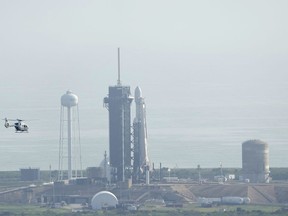Most asteroids are typically rocky or icy, and that is the primary exploration of a steel world.

CAPE CANAVERAL, Fla. — NASA’s Psyche spacecraft rocketed away Friday on a six-year journey to a uncommon metal-covered asteroid.
Most asteroids are typically rocky or icy, and that is the primary exploration of a steel world. Scientists consider it could be the battered stays of an early planet’s core, and will make clear the inaccessible facilities of Earth and different rocky planets.
SpaceX launched the spacecraft into an overcast midmorning sky from NASA’s Kennedy House Middle. Named for the asteroid it’s chasing, Psyche ought to attain the large, potato-shaped object in 2029.
“It’s so thrilling,” mentioned Laurie Leshin, director of NASA’s Jet Propulsion Laboratory. Added Arizona State College’s Jim Bell, a part of the Psyche workforce: “What an ideal trip to this point.”
An hour later, the spacecraft separated efficiently from the rocket’s higher stage and floated away, drawing applause from floor controllers.
After many years of visiting faraway worlds of rock, ice and gasoline, NASA is psyched to pursue one coated in steel. Of the 9 or so metal-rich asteroids found to this point, Psyche is the most important, orbiting the solar within the outer portion of the primary asteroid belt between Mars and Jupiter alongside hundreds of thousands of different area rocks. It was found in 1852 and named after Greek mythology’s fascinating goddess of the soul.
“It’s lengthy been people’ dream to go to the steel core of our Earth. I imply, ask Jules Verne,” lead scientist Lindy Elkins-Tanton of Arizona State College mentioned forward of the launch.
“The stress is simply too excessive. The temperature is simply too excessive. The expertise is unimaginable,” she mentioned. “However there’s a method in our photo voltaic system that we are able to have a look at a steel core and that’s by going to this asteroid.”
Astronomers know from radar and different observations that the asteroid is huge — about 144 miles (232 kilometres) throughout at its widest and 173 miles (280 kilometres) lengthy. They consider it’s brimming with iron, nickel and different metals, and fairly presumably silicates, with a boring, predominantly grey floor doubtless lined with wonderful steel grains from cosmic impacts.
In any other case, it’s a speck of sunshine within the evening sky, filled with thriller till the spacecraft reaches it after travelling greater than 2 billion miles (3.6 billion kilometres).
Scientists envision spiky steel craters, big steel cliffs and metal-encrusted eroded lava flows greenish-yellow from sulfur — “nearly sure to be utterly unsuitable,” in response to Elkins-Tanton. It’s additionally attainable that hint quantities of gold, silver, platinum or iridium — iron-loving components — might be dissolved within the asteroid’s iron and nickel, she mentioned.
“There’s an excellent probability that it’s going to be outdoors of our imaginings, and that’s my fondest hope,” she mentioned.
Believed to be a planetary constructing block from the photo voltaic system’s formation 4.5 billion years in the past, the asteroid will help reply such elementary questions as how did life come up on Earth and what makes our planet liveable, in response to Elkins-Tanton.
On Earth, the planet’s iron core is answerable for the magnetic subject that shields our ambiance and allows life.
Led by Arizona State College on NASA’s behalf, the $1.2 billion mission will use a roundabout path to get to the asteroid. The van-size spacecraft with photo voltaic panels large enough to fill a tennis court docket will swoop previous Mars for a gravity increase in 2026. Three years later, it would attain the asteroid and try to enter orbit round it, circling as excessive as 440 miles (700 kilometres) and as shut as 47 miles (75 kilometres) till not less than 2031.
The spacecraft depends on photo voltaic electrical propulsion, utilizing xenon gas-fed thrusters and their mild blue-glowing pulses. An experimental communication system can be alongside for the trip, utilizing lasers as an alternative of radio waves in an try and develop the move of information from deep area to Earth. NASA expects the take a look at to yield greater than 10 instances the quantity of information, sufficient to transmit movies from the moon or Mars in the future.
The spacecraft ought to have soared a yr in the past, however was held up by delays in flight software program testing attributed to poor administration and different points. The revised schedule added further journey time. So as an alternative of arriving on the asteroid in 2026 as initially deliberate, the spacecraft received’t get there till 2029.
That’s the identical yr that one other NASA spacecraft — the one which simply returned asteroid samples to the Utah desert — will arrive at a distinct area rock because it buzzes Earth.

